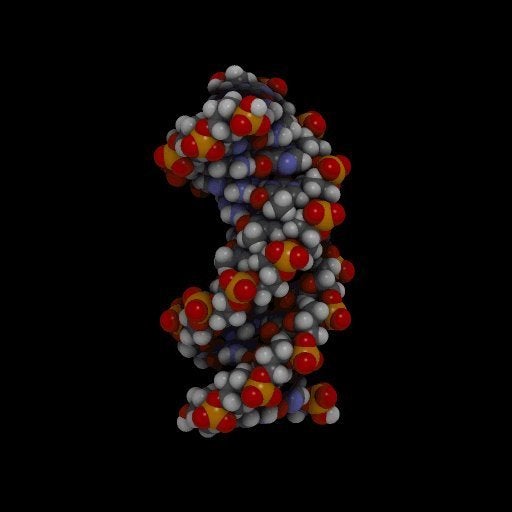
An interesting story emerged last week about the origins of life on Earth. Every organism, regardless of size, habitat, or biology, uses a genetic blueprint involving DNA and RNA. But are DNA and RNA really the only molecules that can store and transmit genetic information? Or were they simply the most successful players in a molecular lottery played out billions of years ago?
The question, of course, is likely never to be answered definitely, as no organism from that period currently exists. But, as was widely reported last week (see, for instance, here and here, and my take here), the research team, led by Philipp Holliger and Vitor Pinheiro at the Medical Research Council Laboratory of Molecular Biology in Cambridge, U.K., demonstrated that polymers comprised of building blocks not found in nature (called XNAs) can store and transmit genetic information, at least in a test tube. Those molecules can even evolve -- again, in a test tube -- the ability to bind to other molecules just as proteins can, in a process akin to Darwinian evolution.
Those findings, reported April 20 in Science, allow the possibility that eons ago, organisms may have -- may have! -- existed that did not use DNA and RNA. The reason we don't see those organisms today, the argument goes, is that they simply failed to thrive or compete against their more fit DNA/RNA-based neighbors.
For Pinheiro, the advantage of the system is its implications for genetic therapeutics development: XNA polymers should be resistant to the enzymes that normally destroy injected DNAs and RNAs. But the most interesting part of the story for me was just how the authors were able to draw their conclusions in the first place.
They did it by creating enzymes that are able to use DNA/RNA analogs that are never found in nature.
The authors took an enzyme, called a DNA polymerase, whose job is to faithfully replicate cellular DNA, and produced versions that would instead read DNA and produce a copy in another language.* They then built a second set of proteins that could read that new XNA language and copy it back into DNA. This from a protein tasked with the most critical task a cell can perform: faithfully duplicating DNA for the next generation of cells.
That's a remarkable achievement. So how did they do it?
Well, they started with a slightly tweaked protein, for one thing, a mutant enzyme already lacking some of the functions they expected might interfere with XNA synthesis. They then applied a method they called "compartmentalized self-tagging," or CST.
In CST Pinheiro explains, "you try to link genotype" -- that is, DNA -- "to phenotype," or behavior. CST sifts through a massive collection of polymerase mutants such that the mutants that can do what you want (that is, have the desired phenotype -- in this case, copying DNA to XNA) are selected, along with the gene that encodes the desired mutant itself. Metaphorically, says Pinheiro, the process is like dealing with an emergency on a plane: "The captain falls ill and the idea is that you are trying to find whether someone in the plane is a doctor." (This would be a very, very large plane: Each screen included some 200 million mutants.)
Pinheiro and his team created an emulsion -- like the tiny droplets of oil in a vinaigrette salad dressing -- in which each droplet, basically a nanoscale test tube, contained a circular piece of DNA (a "plasmid") encoding one of those 200 million variants; a mixture of XNA building blocks; and a small piece of DNA (a "primer") that could bind to the plasmid, albeit weakly. This primer was tagged with biotin, a kind of molecular handle.
If the polymerase in any given droplet could extend its primer (as polymerases do) using XNA nucleotides, it would create a stable complex of primer and plasmid. Those complexes could then be captured via the primer's biotin handle, such that after a single screening round the large pool of mutant plasmids would be whittled down, or enriched, to a more manageable pool, which could then be used directly or passed through the process again for further enrichment.
This process, which can occur very rapidly in a test tube, is like running evolution in super-fast-forward, selecting for desired properties and weeding out poor performers. And it is not unique to this paper: A process called "phage display" works similarly to identify synthetic antibodies that can bind to desired protein targets.
In this case the process enabled the research team to create a suite of proteins the likes of which have never been seen on Earth -- proteins that can translate the language of DNA into a new language altogether. But let's put that achievement in perspective:
The authors did not play God in a test tube; they selected for an enzymatic activity using a highly sophisticated form of find-the-needle-in-the-haystack. Nor did they develop some new form of life -- though one could imagine XNA polymers being used to store the genetic blueprints for some hypothetical synthetic organism.
But that's in the future. At least for the moment, DNA and RNA will remain alone, and safely at the top of the genetic heap -- right where evolution, for whatever reason, placed them.
*Well, not exactly. DNA is a double-stranded molecule that looks like a helical ladder, with a sugar-phosphate backbone on the outside and rungs of paired DNA bases on the inside. It's the precise order of bases that gives DNA meaning, and Holliger's team didn't change that - the same base-pairing rules apply in their XNA polymers as in DNA and RNA, and in fact, XNA polymers can base pair with DNA. What the team did was to replace the sugars with something completely novel.